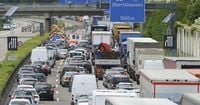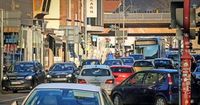Across Germany, motorists are grappling with mounting traffic congestion, especially in key urban and regional hubs where construction projects and accidents have significantly slowed travel. From Celle in Lower Saxony to the bustling highways of North Rhine-Westphalia, current traffic updates reveal a complex web of bottlenecks affecting daily commutes and regional connectivity.
In Celle and its surrounding areas, drivers face notable slowdowns on major routes such as the A7 motorway and federal roads B3, B191, and B214. Construction work on the Wilhelm-Heinichen-Ring in Celle demands detours and caution, prompting officials to urge motorists to avoid the area if possible. The Bundesstraße 3, a vital artery running south towards Hannover and Soltau, along with the B214 towards Braunschweig and Schwarmstedt, and the B191 heading to Uelzen, are all experiencing congestion. These disruptions are being closely monitored, with data sourced from TomTom's extensive GPS network, which collects information from millions of devices and official sensors, updating traffic conditions every five minutes to provide timely alerts.
Further south, the Main-Kinzig-Kreis region including Gelnhausen and the greater Frankfurt area contends with traffic challenges on the A3, A45, and A66 motorways, as well as federal roads B8, B43, B45, B276, B457, and B521. The GNZ-Staumelder highlights these routes as critical points where traffic slows down, often due to construction or accidents. The region's dense road network and proximity to Frankfurt's economic center make these delays particularly impactful for commuters and freight transport alike.
Brandenburg an der Havel, located in the state of Brandenburg, also reports significant traffic slowdowns. The A2 motorway towards Magdeburg in the southwest is a hotspot, alongside federal roads B1 and B102, which traverse the city from east to west and north to south, respectively. Inner-city streets like Potsdamer Straße and Ziesarer Landstraße serve as alternative routes but are themselves prone to congestion, especially when the A2 is heavily trafficked. The MAZ-Staumelder's real-time data, again sourced from TomTom, ensures that residents and travelers receive up-to-date information to navigate these busy corridors.
In the central German city of Marburg and its district of Marburg-Biedenkopf, traffic congestion is prevalent on several federal roads including B3, B62, B236, B252, B253, B255, B453, and B454. These routes form the backbone of regional traffic flow, connecting Marburg to neighboring towns and facilitating access to larger highways. Construction projects and occasional accidents exacerbate delays, prompting the use of the OP-Staumelder to keep travelers informed.
Turning to North Rhine-Westphalia, the traffic situation intensifies dramatically. The region's highways rank among Germany's most congested, with the A1 and A46 motorways near Remscheid and Wuppertal identified as some of the top six most traffic-prone routes in 2023, according to ADAC data. The A1 section between Cologne and Dortmund alone accounted for nearly 6,500 hours of congestion last year, underscoring the severity of traffic woes. Similarly, the A46, connecting Düsseldorf and Wuppertal, is a critical corridor experiencing persistent jams, compounded by the ongoing decade-long reconstruction of the Wuppertal-Nord motorway interchange—a mammoth infrastructure project that promises long-term improvements but currently adds to the disruption.
Remscheid's federal roads such as B229, B237, and B51/B51n, along with state roads like L74 and L101, serve as vital commuter routes but are frequently slowed by traffic buildup. The B229, for example, cuts through both Radevormwald and Remscheid, linking the region eastward to Westphalia and westward to Solingen via the Müngsten bridge. Congestion is also common around the A1 ramps near Burscheid, particularly at Kaltenherberg, where traffic merges and diverges.
Solingen and its neighboring cities Remscheid and Wuppertal face similar challenges, with the A1, A3, and A46 motorways forming the backbone of regional traffic. Notably, the A3 is the most congested route in North Rhine-Westphalia, with commuters on the Cologne to Oberhausen stretch spending over 10,000 hours stuck in traffic in 2023. Construction at the A3 Solingen junction has intensified delays, frustrating drivers who rely on this key connection. The A46's dual role—linking Wuppertal-Nord and the Ruhr area as well as Düsseldorf and the A3—makes it indispensable but also a choke point.
Federal roads like B229 and B224 in Solingen are crucial for intra-city travel and access to motorways. The B229 runs east-west through the city, connecting to Remscheid and the A3, while the B224 links Solingen-Mitte with Wuppertal-Vohwinkel and the A46. State roads such as L357 Roggenkamp, which connects Gräfrath to the A46 at Haan-Ost, and the “Stadtautobahn” Viehbachtalstraße are also integral parts of the network but face their share of congestion.
Additional important streets in Solingen include Cronenberger Straße, Katternberger Straße, Bonner Straße, and several others that handle significant local traffic. The cumulative effect of construction, accidents, and sheer traffic volume makes careful navigation and patience essential for drivers in the region.
Across all these regions, traffic data is predominantly sourced from TomTom, a leading navigation system provider. TomTom aggregates GPS data from millions of devices, automatic inputs from approximately 80 million mobile devices, several million official road sensors, and manually maintained reports. This comprehensive data collection allows for accurate and timely traffic updates, refreshed every five minutes, ensuring drivers receive the latest information to adjust their routes accordingly.
Other navigation platforms like Google Maps, Apple Maps, and Garmin also provide traffic information, but the regional traffic reporters emphasize TomTom's data for their real-time congestion warnings. The consistent message across all regions is a call for motorists to exercise consideration and patience, as these traffic challenges affect not just individual commuters but entire communities and economies.
Whether navigating the federal roads of Marburg or the congested motorways of North Rhine-Westphalia, drivers must stay alert to dynamic traffic conditions. Construction projects, while disruptive, are vital for long-term improvements, and accidents will inevitably cause delays. By leveraging real-time data and remaining courteous on the road, motorists can better manage their journeys amid Germany's evolving traffic landscape.







